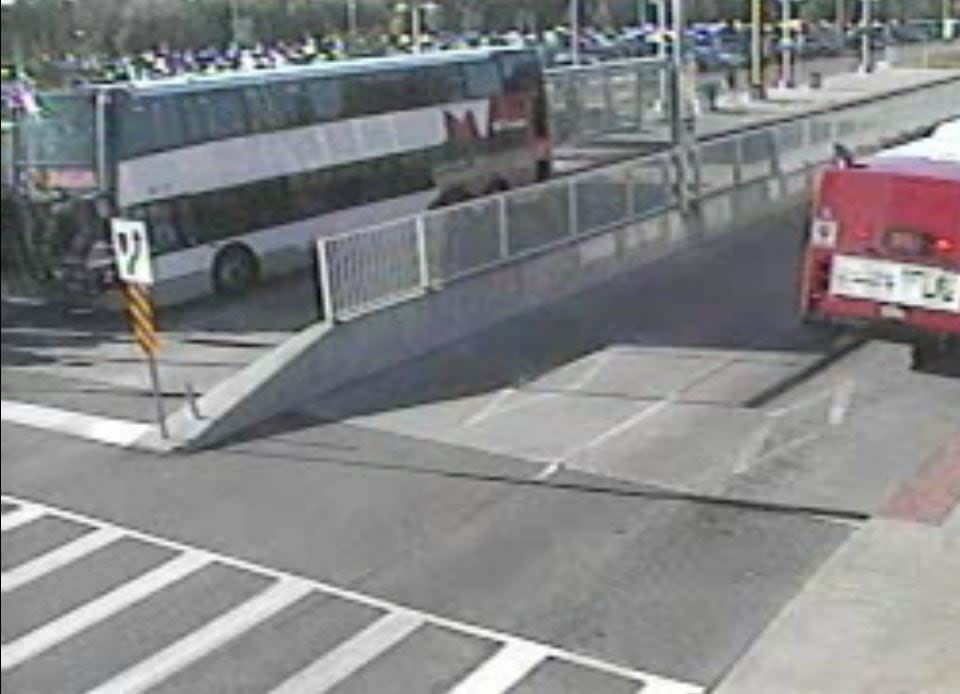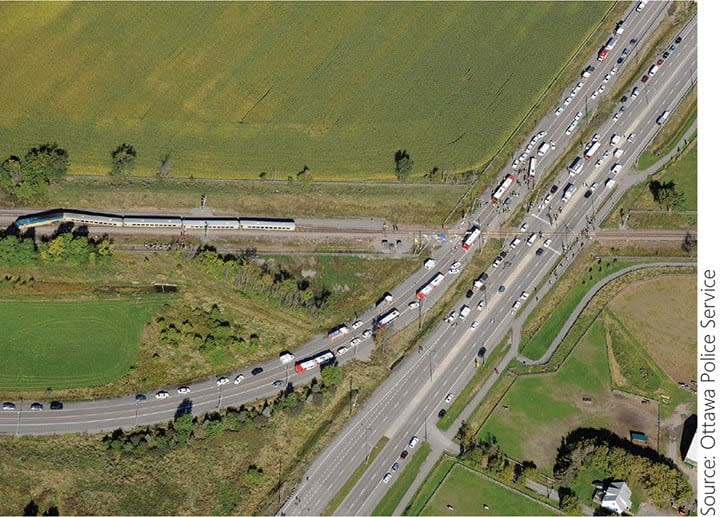10 years later, crossing where bus and train collided largely unchanged

Ten years after an OC Transpo bus smashed into a Via Rail passenger train in south Ottawa, killing six, a key safety improvement recommended in the wake of the tragedy — grade separation at the busy crossing — remains unfulfilled, and could still be years away.
The collision on Sept. 18, 2013, occurred on a crystal clear morning just east of Fallowfield station in Barrhaven, where the Transitway curves north and crosses the train tracks before continuing alongside Woodroffe Avenue. Five bus passengers and driver Dave Woodard died in the crash. Dozens more were injured.
In its final report, released in December 2015, the Transportation Safety Board (TSB) concluded the tragedy "was not caused by one single person, action, or organization," citing instead a number of contributing factors.
I just don't see a reason why it's taken 10 years and nothing's been done. I find that unacceptable. - Clint Crabtree, ATU Local 279
Among those was the speed at which bus 8017, a double-decker packed with morning commuters heading downtown, was travelling as it approached the crossing: 67.7 km/h, just over the posted limit of 60 km/h.
At that speed, the TSB calculated the bus would have required 35.9 metres to come to a full stop once Woodard applied the brakes. Unfortunately, it had just 35.6 metres to avoid striking the passing train — a matter of one foot.
Subsequent testing showed that had the bus been travelling at the posted speed limit, it would have stopped well short of the crossing.
"This demonstrates that even a small increase in speed can greatly increase the required stopping distance ... which can lead to an accident," TSB investigators found, noting that OC Transpo generally regarded speeds within 12 km/h of the posted limit to be within the acceptable range.
The report also noted bus 8017 was nearly four minutes behind schedule when it pulled away from the Fallowfield stop at 8:47 a.m.

Five passengers and the bus driver died in the crash. Dozens more were injured. No one aboard the Via Rail train was hurt. (Adrian Wyld/Canadian Press)
Video monitor likely a distraction
Driver distraction likely also played a role in the collision, the TSB found.
At the time, OC Transpo drivers were required to keep an eye on passengers with the aid of a small split-screen video monitor mounted in the upper left corner of their compartment, and remind them that no standing was permitted on the upper deck.
This requirement forced drivers to "periodically glance at the screen while the bus was in motion," the TSB wrote, noting "glances lasting two seconds or longer are significantly associated with accidents and near accidents."

In its 2015 report, the Transportation Safety Board deemed these monitors in the upper left corner of the driver's compartment to be a potential distraction, and recommended Transport Canada work with provincial authorities to develop comprehensive guidelines governing their use. (Transportation Safety Board)
Conversations among passengers standing near Woodard were likely another source of distraction, the report found.
Finally, the TSB noted the alignment of the Transitway itself, which curves sharply to the left as inbound buses approach the rail crossing near Woodroffe, a configuration that "proved to be problematic," especially since the driver's view was obscured by overgrown foliage and a large sign.
All this combined to reduce the driver's "stopping sight distance" to less room than was available, despite the flashing lights, ringing bells and lowered gates at the rail crossing ahead.

This reconstruction shows the view from the driver's seat as an identical bus approaches the crossing. The arrow indicates the 'tangent point,' where bus operators tend to focus their gaze. The circle indicates the 'occlusion point,' which at the time of the collision was obstructed by trees, shrubs, transitway signage and the frame of the vehicle itself. (Transportation Safety Board)
5 recommendations
The TSB issued five recommendations stemming from its investigation, four of which were aimed at Transport Canada, which was urged to implement the following:
Comprehensive guidelines governing the installation and use of in-vehicle video monitor displays.
Crashworthiness standards for commercial passenger buses to reduce the risk of injury.
Mandatory event data recorders, or "black boxes," on board commercial passenger buses.
Specific guidance regarding grade separation — overpasses or underpasses — at crossings such as the one where the 2013 crash occurred.
In an update last week, the TSB confirmed Transport Canada updated its guidance regarding video monitors in February 2019, and two months later issued new guidelines for assessing grade separation, but has failed to make adequate headway on the other two items.
The TSB's fifth recommendation urged the City of Ottawa to "reconsider the need for grade separation at the Woodroffe Avenue, Transitway, and Fallowfield Road level crossings," regardless of any federal guidelines or legislation.
In fact, the city has been planning for just such a project for at least two decades, relying initially on environmental assessments conducted in the 1990s. Residents were opposed to the notion of an overpass, however, and by early 2003 engineers had deemed subsurface conditions in the area unsuitable for an underpass.
The project was revived in 2017 when city council approved a feasibility study for grade-separated crossings at Woodroffe, Fallowfield and the Transitway. By 2020, the concept plan had advanced to the functional design phase with the approval of an environmental assessment of Stage 3 LRT, which will eventually reach Barrhaven.
That report will be formally filed next month, and the province is expected to sign off on the project next April.

Bus 8017, left, pulls away from Fallowfield transit station in this CCTV image obtained by CBC News. Seconds later, it would collide with a passing train at a nearby level crossing. (City of Ottawa)
A costly project
According to a statement attributed to Vivi Chi, the city's director of transportation planning, the two projects could occur separately, but it would be extremely costly.
"While the current plan is to construct the three grade-separations at the same time as the Barrhaven LRT, there is the option of proceeding with the crossings separately, at a cost of approximately $535 million (in 2023 dollars)," Chi wrote.
"The City is committed to working with senior levels of government to secure potential future funding opportunities for this project so that it can proceed to detailed design and construction."

This aerial photo shows the aftermath of the collision on Sept. 18, 2013. Bus 8017 can be seen straddling the train tracks while Via passenger train 51 sits partially derailed. (Ottawa Police Service)
According to the TSB, while timelines have not been specified, "the City of Ottawa estimates that it will be at least 8 years in the future, and it will depend on funding and contributions from senior levels of government."
Nevertheless, the board believes the city has demonstrated "satisfactory intent" to complete the project.
Some are less patient, however.
Growing impatience
"That is an item that should have been actioned immediately. It should have taken precedence over everything," said Clint Crabtree, president of Amalgamated Transit Union Local 279, which represents OC Transpo drivers and other employees.
"I just don't see a reason why it's taken 10 years and nothing's been done. I find that unacceptable."
The city has taken other steps toward improving safety near the crash site, including keeping the approach clear of any visual obstruction and reducing the speed limit there to 50 km/h. According to the TSB, OC Transpo has stepped up speed monitoring.
Drivers also face fewer distractions thanks to the introduction of Plexiglas shields, and those on-board monitors are now disabled while the bus is in motion.
Additionally, Via Rail and the city have improved communications regarding crossings where trains and traffic meet.

Barrhaven East Coun. Wilson Lo became an OC Transpo driver just months after the fatal crash in the ward he now represents. (Jean Delisle/CBC)
According to Barrhaven East Coun. Wilson Lo, a former OC Transpo driver who now represents the ward where the 2013 collision occurred, OC Transpo is "constantly" reminding drivers to remain vigilant as they approach level crossings.
"That culture of safety around those railway crossings has certainly improved and been really drilled into operators' minds," Lo said. "[The crash] was something that woke up something in the organization about railway crossings in general."
While Lo noted some residents remain "very strongly in favour" of grade-separation despite the enormous cost and inevitable disruption such a project will bring, he acknowledged the city will likely mark more of these grim anniversaries before it's realized.
"Even if it does get funded it's going to be several [more] years before shovels get into the ground," he said.
While the TSB isn't mandated to enforce its recommendations, the board said in an email on Friday it will continue to request updates from the city.
"While the Board recognizes that the grade separation projects are a significant undertaking requiring planning, consultations, various levels of approval, and funding in order to proceed, until the grade separations are constructed, the identified risks will remain," the TSB wrote.


